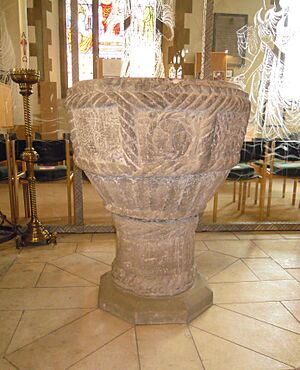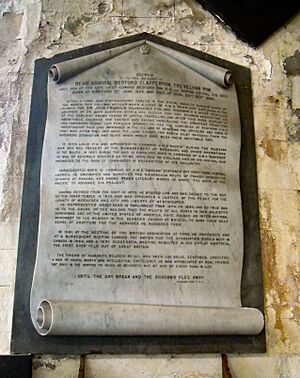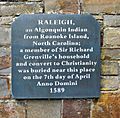Church of St Mary, Bideford facts for kids
Quick facts for kids Church of St Mary |
|
|---|---|
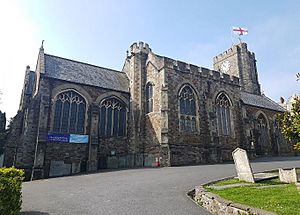
St Mary's Church in 2018
|
|
| Lua error in Module:Location_map at line 420: attempt to index field 'wikibase' (a nil value). | |
| Location | Bideford, Devon |
| Country | England |
| Denomination | Church of England |
| Architecture | |
| Functional status | active |
| Heritage designation | Grade II* |
| Architect(s) | Edward Ashworth (rebuilt) |
| Years built | 15th century (original) 1862–1865 (rebuilt) |
| Administration | |
| Diocese | Exeter |
The Church of St Mary is a special church in Bideford, Devon, England. It belongs to the Church of England. The church you see today was built in 1865. It replaced a much older church from the year 1260. This church is so important that it has been a Grade II* listed building since 1949. This means it is a very important historic place.
History and What It Looks Like
The current church was built between 1862 and 1865. It was designed by an architect named Edward Ashworth. This church was built on the same spot where an even older church stood. That first church was from the Saxon times, before the Normans arrived.
The oldest part of the church is its strong tower, which dates back to 1260. It is the only part left from the original building. The tower has a special top with battlements, like a castle. Inside the tower are eight bells. Five of these bells were made in 1722, and three more were added in 1876. Next to the tower, you can see the town's War Memorial. It lists the names of people from Bideford who died in the two World Wars.
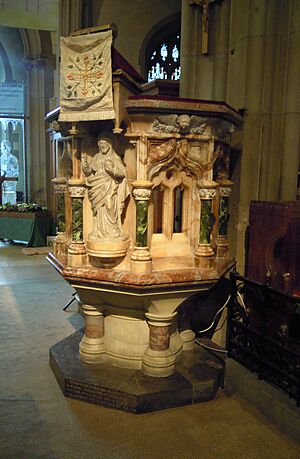
Near the main entrance, there is an old holy water stoup. It is very old, but no one knows its exact age. Close by, you can find records about a Native American person named Raleigh. He was one of the first Native Americans to come to England. He was also the first Native American to become a Christian and be buried in England.
Inside the Church
The All Saints' Chapel is a special area inside the church. It used to be where the Mayor and important people of Bideford sat. The Votive Stand, a place for candles, was made for the Mothers' Union. It was blessed in 1999. It looks like the baptismal font and also like a signal beacon. On the altar, there is a Memorial Book that started in 2006.
A beautiful glass screen separates the chapel from the north side of the church. It was engraved by Peter Tysoe and dedicated in 1982. The screen shows pictures of Jesus being baptized by John the Baptist. It also shows his disciples, John, James, and Peter. Other panels show important figures like Mother Teresa and Saint Boniface.

The main part of the church, called the nave, has arches that divide it into sections. The baptismal font is on the east side of the north door. It is a large, round stone bowl carved from granite. It has eight panels, but only three are carved. This font is very old, from around 1080. Its carvings might show a mix of Saxon and Norman styles.
There is a story that Oliver Cromwell's soldiers threw the font out during the English Civil War. They supposedly used it as a trough for animals. The screen at the bottom of the tower is made from old wooden bench ends. These were saved when the older Norman church was taken down. This screen has some lovely carvings from the early Tudor period. It also shows the coat of arms of the famous local Grenville family.
The pulpit, where sermons are given, was added in 1894. It is made of beautiful marble from Ashburton in south Devon. Devon craftsmen carved it with columns and a figure of Christ. To the right of the altar, you can see the tomb of Sir Thomas Grenville. He died in 1513. His family, the Grenvilles, supported the church in Bideford for many years.
Sir Thomas's tomb has a figure of him in armor. His feet rest on a dog. His hands are together in prayer, holding a ball-shaped object. This object is believed to represent his heart. An old Latin message is carved above his tomb. It says that Sir Thomas Grenville, a knight and supporter of the church, died on March 18, 1513.
Sir Thomas Grenville's great-grandson was the captain of the Mary Rose. This famous ship sank in 1545. His great-great-grandson was Sir Richard Grenville. He was a famous sailor and explorer during the time of Queen Elizabeth I. He was the captain of the ship Revenge. He bravely fought against many Spanish ships in 1591 and refused to give up his ship.
Interesting Stories
In 1549, during a time of religious change called the Prayer Book Rebellion, something unusual happened in the churchyard. A priest named Rev Richard Gilbert had an argument with a group of people bringing a coffin for burial. The priest refused to hold the funeral service unless he was paid with the dead person's best cow. A local leader, Sir William Coffin, heard the argument. He told the priest to do the service right away. When the priest refused, Sir William told the mourners to pretend to bury the priest alive in the grave! They put him in the hole and started to fill it. When only his head was showing, the terrified priest promised to do the service without payment.
On the south wall of the church, there is a statue of John Strange. He was a local merchant and helped the town and church a lot. He was Mayor of Bideford four times. He died in 1646 from the plague while helping others who were sick.
On the north wall, near the main entrance, you can find a large memorial to Admiral Bedford Clapperton Trevelyan Pim. He was a Royal Navy officer and an Arctic explorer. He searched for the lost Franklin Expedition. He was the first person to travel from a ship on the east side of the Northwest Passage to one on the west side.
The church has many stained-glass windows. They were all made in the late 1800s. The east window was made by Alexander Gibbs in 1865. The north window was made by Arthur J. Dix.
The church organ is a large instrument with three keyboards. It was made by "Father" Willis of London and installed in 1865. It was updated in 1971. Nearby, in a glass case, you can see a special book from 1567. It is a copy of Apology of the Church of England. Queen Elizabeth I asked Bishop John Jewel to write this book to explain the ideas of the Protestant faith. Copies were ordered to be chained in all churches in England and read aloud every Sunday. Bishop Jewel studied in nearby Barnstaple.
Gallery
-
The "Father Willis" organ of 1865
-
Commemorative plaque for Raleigh, a Native American who was buried in the churchyard on his death in 1589


